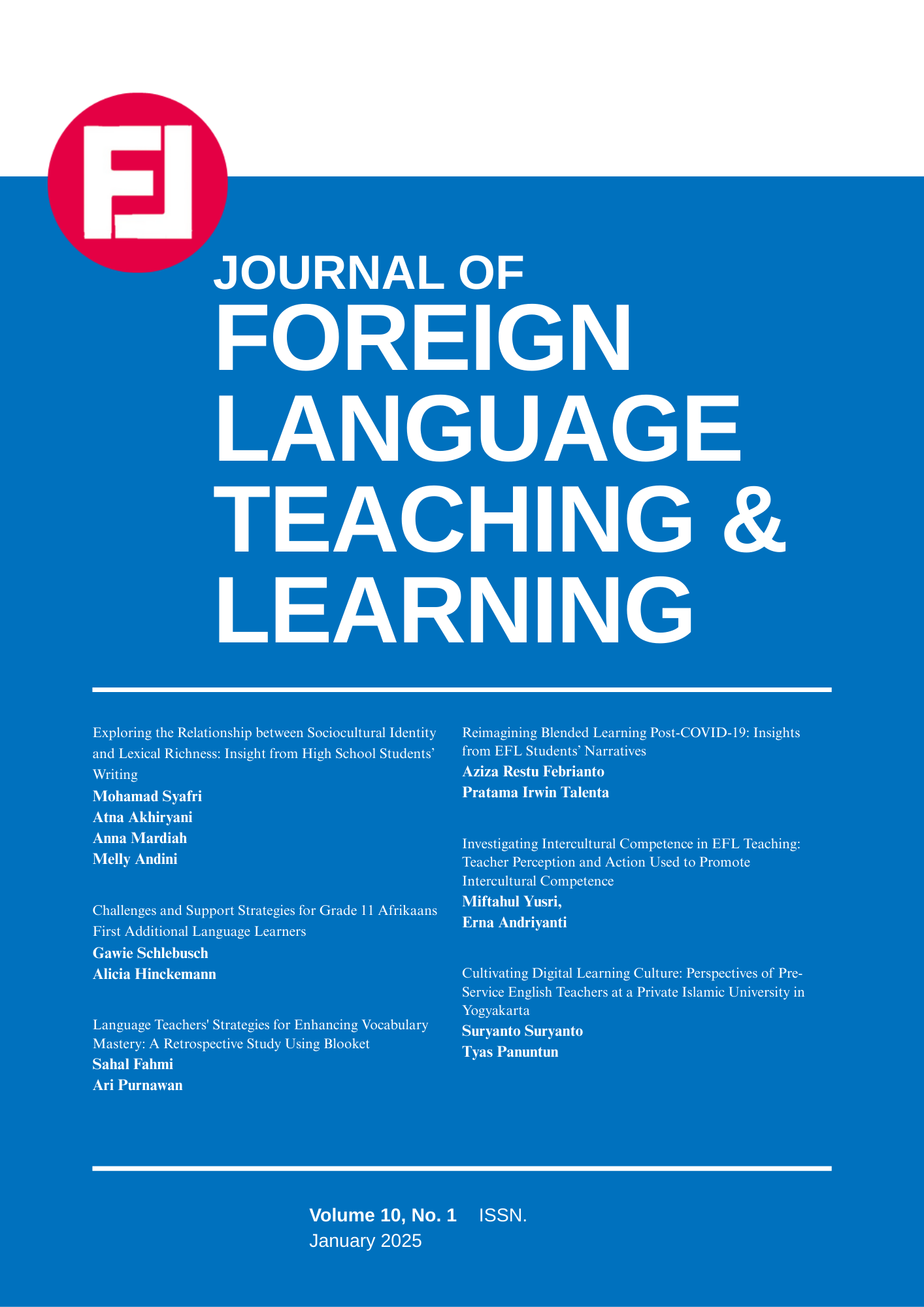Challenges and Support Strategies for Grade 11 Afrikaans First Additional Language Learners
DOI:
https://doi.org/10.18196/ftl.v10i1.25477Keywords:
Acquisition, Challenges, Second Language, SupportAbstract
Background: The article explores the challenges and support strategies for Grade 11 Afrikaans First Additional Language (FAL) learners. The Curriculum and Assessment Policy Statement (CAPS) outlines a detailed framework for teaching all subjects in South Africa's basic education system. According to CAPS, learners in the Further Education and Training (FET) phase must study at least two official languages from the South African constitution. One of these must be the learner’s home language (HL), while another official language can be taught as a first additional language. CAPS also mandates that from Grade 1, learners begin learning a second language, referred to as FAL.
Objective: This qualitative study aims to identify the challenges learners face in the Afrikaans FAL classroom, focusing on language skills and examination papers. It also seeks to explore specific areas of difficulty and offer insights to inform teaching practices and support in the classroom.
Methods: A qualitative phenomenological approach was employed, with data collected through individual and focus group interviews. Semi-structured interviews were conducted with Grade 11 Afrikaans FAL teachers and learners, using purposeful sampling for participant selection.
Findings: The findings revealed that learners faced significant challenges in mastering Afrikaans, especially in reading, writing, and speaking. These difficulties were influenced by negative transfer from their home language, limited vocabulary, and lack of exposure to Afrikaans.
Conclusion: Negative attitudes towards the language further reduced motivation and engagement, while the support provided did not adequately address learners’ needs, highlighting gaps in both classroom support and resources from the Department of Basic Education (DBE).
References
Abrar, M., Mukminin, A., Habibi, A., Asyrafi, F., Makmur, M., & Marzulina, L. (2018). “If our English isn’t a language, what is it?” Indonesian EFL student teachers’ challenges speaking English. The Qualitative Report, 23(1), 129–145. https://nsuworks.nova.edu/tqr/vol23/iss1/9
Abedi, D. (2017). The relationship between depth of vocabulary knowledge and reading comprehension of Iranian EFL learners. Journal of Applied Linguistics and Language Research, 4(4), 224–229. https://www.jallr.com/index.php/JALLR/article/view/ 606/pdf606
Andrade, C. (2020). Sample size and its importance in research. Indian Journal of Psychological Medicine, 42(1), 1–103. https://doi.org/10.4103/IJPSYM.IJPSYM_504_19
Ariyanti, A. (2016). Psychological factors affecting EFL students’ speaking performance. ASIAN TEFL Journal of Language Teaching and Applied Linguistics, 1(1), 91–102. http://dx.doi.org/10.21462/asiantefl.v1i1.14
Bingol, M. A., Celik, B., Yildiz, N., & Mart, C. T. (2014). Listening comprehension difficulties encountered by students in second language learning class. Journal of Educational and Instructional Studies in the World, 4(4), 1–6. https://arastirmax.com/tr/system/files/dergiler/116392/makaleler/4/4/arastirmax-listening-comprehension-difficulties-encountered-students-second-language-learning-class.pdf
Chivanga, S. Y. (2016). Qualitative research and evaluation methodology and numbers. Journal of Social Sciences, 47(2), 119–122. DOI:10.1080/09718923.2016.11893551
Chuenchaichon, Y. (2022). The problems of summary writing encountered by Thai EFL students: A case study of the fourth-year English major students at Naresuan University. English Language Teaching, 15(6), 15–31. https://doi.org/10.5539/elt.v15n6p15
Cronje, M. M. (2021). New approaches and strategies for teaching African children initial reading. Literator, 42(1), a1716. https://doi.org/10.4102/lit.v42i1.1716
Curriculum Assessment Policy Statement (CAPS). (2011). Afrikaans First Additional Language, Grade 10-12. Department of Basic Education. Government Printer.
Dar, M. F., & Khan, I. (2015). Writing anxiety among public and private sectors Pakistani undergraduate university students. Pakistan Journal of Gender Studies, 10(1), 121–136. DOI:10.46568/pjgs.v10i1.232
Diko, M. (2022). SisiXhosa osikhathalele ngantoni na esi ude usindwe ziincwadi ezingaka? Why do you care about isiXhosa so much that you are overwhelmed by so many books? Southern African Linguistics and Applied Language Studies, 40(2), 123–134. https://doi.org/10
Dornbrack, J., & Dixon, K. (2014). Towards a more explicit writing pedagogy: The complexity of teaching argumentative writing. Reading & Writing, 5(1), 1–8. https://doi.org/10.4102/rw.v5i1.40
Dreyer, M. (2017). Addressing barriers to learning in first additional language (second language). In M. D. Magano, S. Mohapi, & D. Robinson (Eds.), Realigning teacher training in the 21st century (pp. 203–216). Cengage Learning EMEA.
Eunson, B. (2020). C21 communicating in the 21st century (4th ed.). Wiley.
Habók, A., Magyar, A., & Molnár, G. (2022). Investigating the relationship among English language learning strategies, language achievement, and attitude. Frontiers in Psychology, 13, 867714. https://doi.org/10.3389/fpsyg.2022.867714
Hapsari, E. W., & Sukavatee, P. (2018). Second language writing instruction: A recent practice in Indonesia. Journal of Linguistic and English Teaching, 3(1), 24–48. https://doi.org/10.24903/sj.v3i1.154
Heugh, K., & Stroud, C. (2020). Multilingualism in South African education: A southern perspective. In R. Hickey (Ed.), English in multilingual South Africa: The linguistics of contact and change (pp. 216–238). Cambridge University Press.
Hu, X., Zhang, X., & McGeown, S. (2024). Foreign language anxiety and achievement: A study of primary school students learning English in China. Language Teaching Research, 28(4), 1594–1615. https://doi.org/10.1177/13621688211032332
Hyseni, B., & Lundberg, M. (2022). Effective strategies to reduce language anxiety and fostering spoken English skills (Master’s thesis). Malmö University.
Jafari, K., & Hashim, F. (2015). Comparison of normal and moderately slow speech rates: Listening to students’ voices in listening comprehension classes in EFL context. International Journal of Foreign Language Teaching in the Islamic World, 3(3), 5–11.
Kao, Y. T., & Kuo, H. C. (2021). Diagnosing L2 English learners’ listening difficulties and learning needs through computerized dynamic assessment. Interactive Learning Environments, 0(0), 1–25. https://doi.org/10.1080/10494820.2021.1876738
Kara, H., & Pickering, L. (2017). New directions in qualitative research ethics. International Journal of Social Research Methodology, 20(3), 239–241. https://doi.org/10.1080/13645579.2017.1287869
Kekeya, J. (2021). Qualitative case study research design: The commonalities and differences between collective, intrinsic and instrumental case studies. Contemporary PNG Studies, 36, 28-37.
Khatri, K. K. (2020). Research paradigm: A philosophy of educational research. International Journal of English Literature and Social Sciences, 5(5), 1435–1440. https://doi.org/10.22161/ijels.55.15
Krashen, S. (1982). Principles and practice in second language acquisition. Pergamon Press.
Le, W., & Shuo, W. (2023). The Cultivation of Oral Expression Ability in the Process of Learning English in Secondary Schools. SHS Web of Conferences, 179(34). https://doi.org/10.1051/shsconf/202317902015
Makalela, L. (2015). Translanguaging as a vehicle for epistemic access: Cases for reading comprehension and multilingual interactions. Per Linguam, 31(1), 15–29. https://doi.org/10.5785/31-1-628
Martínez-Mesa, J., González-Chica, D., Duquia, R., Bonamigo, R., & Bastos, J. (2016). Sampling: How do I select participants for my research study? Anais Brasileiros de Dermatologia, 91(3), 326–330. https://doi.org/10.1590/abd1806-4841.20165254
Mathura, S., & Zulu, F. B. (2021). Using flashcards for English second language creative writing in Grade 1. Reading and Writing: Journal of the Reading Association of South Africa, 12(1), 1–8. https://doi.org/10.4102/rw.v12i1.298
Mwita, K. M. (2022). Factors to consider when choosing data collection methods. International Journal of Research in Business and Social Science, 11(5), 532–538.
Ngubane, N. I., Ntombela, B., & Govender, S. (2020). Writing approaches and strategies used by teachers in selected South African English First Additional Language classrooms. Reading & Writing - Journal of the Literacy Association of South Africa, 11(1), 1-10. https://doi.org/10.4102/rw.v11i1.261
Nowell, L. S., Norris, J. M., White, D. E., & Moules, N. J. (2017). Thematic analysis: Striving to meet the trustworthiness criteria. International Journal of Qualitative Methods, 16(1), 1–13. https://doi.org/10.1177/1609406917733847
Ntumi, S. (2016). Challenges pre-school teachers face in the implementation of the early childhood curriculum in the Cape Coast Metropolis. Journal of Education and Practice, 7(1), 54-62.
Nushi, M., & Orouji, F. (2020). Investigating EFL teachers’ views on listening difficulties among their learners: The case of Iranian context. SAGE, 10(2), 1-16. https://doi.org/10.1177/2158244020917393
Oybekovna, O. (2020). Common problems faced by foreign language learners. International Journal on Economics, Finance and Sustainable Development, 2(4), 70-72. https://journals.researchparks.org/index.php/IJEFSD/article/view/466
Pardede, P. (2024). Collaborative writing in EFL settings: A Review. Journal of English Teaching, 10(1). 92-109. https://doi.org/10.33541/jet.v10i1.5631
Pit-ten Cate, I. M., Markova, M., Krischler, M., & Krolak-Schwersdt, S. (2018). Promoting inclusive education: The role of teachers’ competence and attitudes. Insights into Learning Disabilities, 15(1), 49-63.
Powell, S. L. (2017). The effect of a font intervention for 4th and 5th graders with dyslexia (Educational Specialist). https://commons.lib.jmu.edu/edspec201019/116
Pretorius, E. J., & Murray, S. (2019). Teaching reading comprehension. Oxford University Press.
Rajchert, J. M., Zultak, T., & Smulczyk, M. (2014). Predicting reading literacy and its improvement in the Polish National Extension of the PISA study: The role of intelligence, trait- and state-anxiety, socio-economic status, and school-type. Learning and Individual Differences, 33, 1–11. https://doi.org/10.1016/j.lindif.2014.04.003
Renukadevi, D. (2014). The role of listening in language acquisition: The challenges & strategies in teaching listening skills. International Journal of Research in Social Sciences, 4(3), 75-83.
Sidhu, P. S., & Sivaguru, S. (2023). Students’ perception of the challenges in comprehending the English language listening test. Social Sciences, Humanities and Education Journal, 4(3), 523–532.
Swanson, H. L., Kong, J., Petcu, S. D., & Pimental, M. F. A. (2020). Can difficulties in language acquisition and specific learning disabilities be separated among English learners? Exceptional Children, 86, 293–309. https://doi.org/10.1177/0014402919893931
Taherdoost, H. (2022). What are different research approaches? Comprehensive review of qualitative, quantitative, and mixed method research, their applications, types, and limitations. Journal of Management Science & Engineering Research, 5(1), 53–63. https://doi.org/10.30564/jmser.v5i1.4538
Tosuncuoglu, I. (2018). Importance of assessment in ELT. Journal of Education and Training Studies, 6(9), 163–167. https://doi.org/10.11114/jets.v6i9.3443
Tuan, N. H., & Mai, T. N. (2015). Factors affecting students’ speaking performance at LE Thanh Hien High School. Asian Journal of Educational Research, 3(2), 8–23.
Van Wingerden, E., Segers, E., Van Balkom, H., & Verhoeven, L. (2017). Foundations of reading comprehension in children with intellectual disabilities. Research in Developmental Disabilities, 60, 211–222. https://doi.org/10.1016/j.ridd.2016.10.015
Vygotsky, L. S. (1978). Mind in society: The development of higher psychological processes. Harvard University Press.
Waring, R., & Vu, H. T. (2020). Challenges setting up extensive reading programs in Vietnam. Journal of Extensive Reading, 5, 11–22.
Xu, W., & Zammit, K. (2020). Applying thematic analysis to education: A hybrid approach to interpreting data in practitioner research. International Journal of Qualitative Methods, 19, 1–9. https://doi.org/10.1177/1609406920918810
Downloads
Published
How to Cite
Issue
Section
License
Copyright (c) 2025 Gawie Schlebusch, Alicia Hinckemann

This work is licensed under a Creative Commons Attribution-ShareAlike 4.0 International License.
Copyright
Authors retain copyright and grant the journal right of first publication with the work simultaneously licensed under a Creative Commons Attribution-ShareAlike 4.0 International License that allows others to share the work with an acknowledgment of initial publication in this journal.
Authors are permitted and encouraged to post their work online (e.g., in institutional repositories, social media account, or on their website) after the article getting published in the journal, as it can lead to productive exchanges and earlier and greater citation of published work (See The Effect of Open Access).License
You are free to:
- Share — copy and redistribute the material in any medium or format
- Adapt — remix, transform, and build upon the material for any purpose, even commercially.
Attribution — You must give appropriate credit, provide a link to the license, and indicate if changes were made. You may do so in any reasonable manner, but not in any way that suggests the licensor endorses you or your use.
ShareAlike — If you remix, transform, or build upon the material, you must distribute your contributions under the same license as the original.
- No additional restrictions — You may not apply legal terms or technological measures that legally restrict others from doing anything the license permits.



.png)





